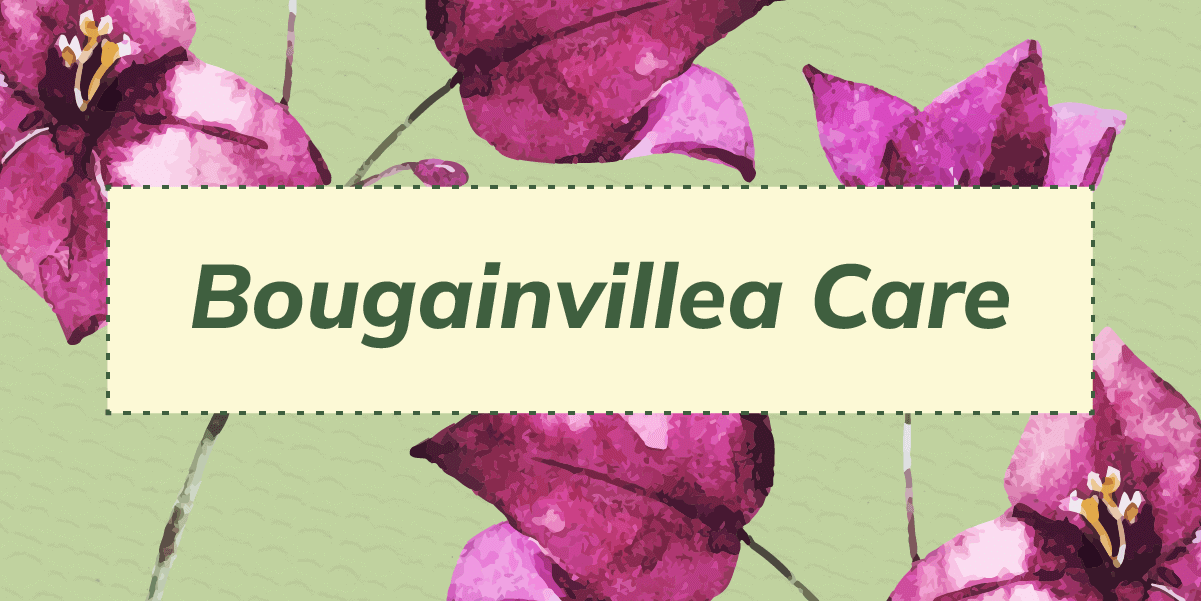The ever-blooming bougainvillea, a shrubby vine covered with bright and gaudy blossoms, is a spectacular sight in the tropics and hot coastal areas of the Americas.
Named in honor of L.A. de Bougainville, a French navigator who lived from 1729 to 1811, the plant is native to South America. First described and classified in 1789, bougainvillea was discovered in Brazil twenty years earlier. Since their petals resemble paper, bougainvillea is popularly known as Paper Flowers.
Botanically, bougainvillea is classified as Bougainvillea Glabra, Bougainvillea Peruviana, or Bougainvillea x Buttiana (a hybrid of the previous two). Most commercial varieties are selections and hybrids of these three main species.
New hybrids appear regularly. The flowers we associate with bougainvillea are red, purple, pink, lavender, orange, white, and bi-color bracts. True bougainvillea flowers are small, white, and tubular, appearing inside these colorful papery bracts.
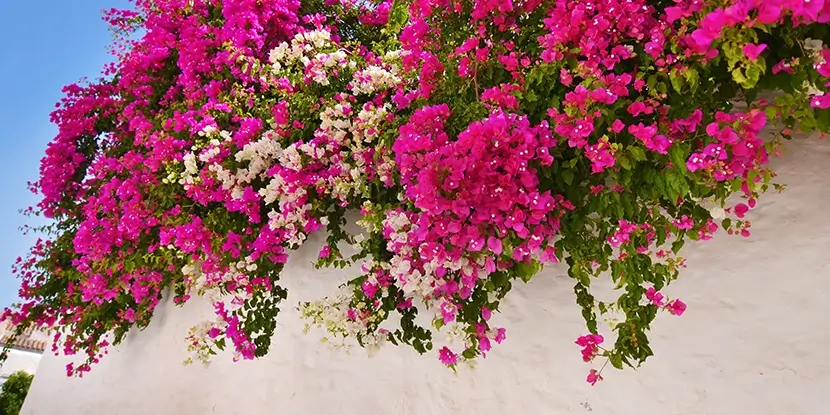
Bougainvillea plants cascading over a wall.
Usually, bougainvillea grows as thorny vines, but recent efforts have produced mostly thornless hybrids. Another trend is developing shrubby plants with more compact habits for container growing.
On average, bougainvillea lives for 20 years or more. Under optimal conditions, such as warm climates, well-draining soil, and regular pruning, it can thrive for several decades.
Propagating Bougainvillea
- Select a strong and healthy bougainvillea plant for cuttings. Look for mature, semi-hardwood stems free of pests and diseases.
- Using sterilized pruning shears, cut a section of the stem approximately 4–6 inches long. Ensure the cutting has at least three to four nodes, and remove leaves from the lower portion.
- Dip the cut end of the stem into a rooting hormone to encourage root development. Shake off any excess powder.
- Insert the treated end of the cutting into a container filled with well-draining, moist potting mix. Bury at least two nodes under the soil.
- To maintain high humidity, cover the cutting with a clear plastic bag or place it in a propagation dome. Avoid direct sunlight, but provide bright, indirect light for optimal growth.
Keep the soil moist but not waterlogged. - After 4–8 weeks, gently tug on the cutting to check for resistance, which indicates root growth.
- Once strong roots have developed, transplant the new plant into a larger container or its permanent location.
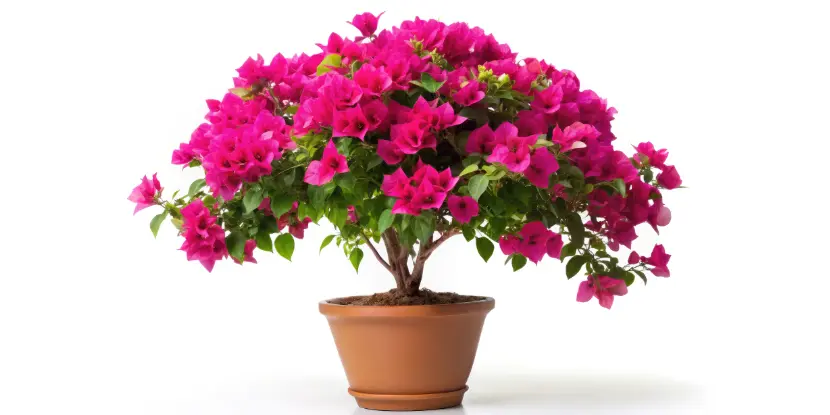
A potted bougainvillea pruned into a shrub.
Planting Bougainvillea
- Select a site with at least 6 hours of direct light daily and well-draining soil.
- Mix organic compost or sand into the soil to improve drainage and fertility. Bougainvilleas prefer slightly acidic to neutral soil with a pH of 5.5 to 6.0.
- Dig a hole twice as wide and as deep as the plant’s root ball. This allows the roots to spread without restriction.
- Carefully remove the bougainvillea from its container to avoid damaging the root system.
- Place it in the hole, ensuring the top of the root ball is level with the surrounding soil. Fill the hole and gently firm the soil around the base.
- Give the plant a deep watering after planting to help establish roots.
- If planting a climbing variety, install a trellis or support structure nearby for the vine to latch onto as it grows.
- Spread a light layer of mulch around the plant to retain moisture and suppress weeds, but avoid piling it against the plant’s stem to prevent rot.
Bougainvillea Care
Light
- Sunlight is probably the most critical factor in bougainvillea cultivation.
- Bougainvillea needs 3/4 to full sunlight — no less — or it won’t bloom.
- Bougainvillea can bloom all year if grown correctly in good light.
Cool weather may retard growth in the winter. A hot greenhouse will encourage new growth, which leads to repeat flowering.
Watering
- NEVER let potted plants wilt during the blooming period or stand in too much water. Bougainvillea needs a “happy medium.”
- After planting in the ground, hold back on watering slightly until the bougainvillea begins to expand its roots — then water as necessary.

The delicate, papery bracts of a bougainvillea plant.
Fertilizing
- A top-dressing with bougainvillea fertilizer will kick-start growth.
- Incorporate a well-balanced slow-release coated fertilizer into the soil at planting time.
- Too much nitrogen in the fertilizer will cause excessive leaf growth and delayed or aborted blooming.
- Iron is vital for good green color, but tends to be unavailable to bougainvillea plants during cold winter weather.
- Soluble, granular iron works well and, unlike sprays, won’t stain leaves and blooms.
Pruning Bougainvillea
- Bougainvillea bloom on new growth.
- With proper pruning, sunlight, and water, plants will repeat a blooming cycle in about 4 weeks.
- A rule of thumb is to prune, once the blooming is over, one-half of the growth ending in a bloom. For example, if the growth where blooming occurs has grown out 6 inches, prune off the old bloom cluster, plus 3 inches of the stem after blooming.
- Also, “pinching” the tips of your bougainvillea encourages new growth and flowers and maintains a compact, manageable plant.
Winter & Spring Care
- For winter protection of in-ground plants, mound or “bank” soil 6 inches over the roots and lower plant stems. Leave this all winter and allow the outer stems to freeze.
- Once the chances of freezing have passed in the spring, cut the plants back to this soil mound and wash the mound away, leaving the lower stems exposed.
- With steady light, warm temperatures, and watering, bougainvillea should begin budding in about 4 weeks.
- Keep potted bougainvillea plants out of 32 degrees and colder weather by moving them inside for the duration of freezing temperatures.
- If the leaves burn from wind or frost, give your plant good warmth and light. It should begin growing back within 10 to 20 days and bloom in the expected 4-week time frame.
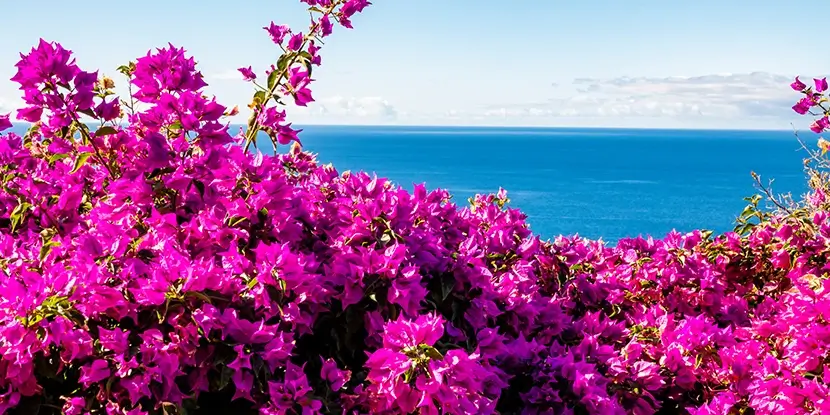
A beautiful ocean view framed by Bougainvillea.
Pest Control
Aphids are the most common bougainvillea pest we encounter. Other common pests include:
- Leaf Miner
- Scale Insects
- Thrips
- Spider Mites
- Slugs and Snails
Natural control methods include:
- Introducing beneficial insects like ladybugs or lacewings to prey on aphids and other small pests
- Regularly spraying the plant with a solution of neem oil and water to deter pests like aphids, thrips, and mites
- Pruning affected areas and removing infested leaves to reduce pest populations
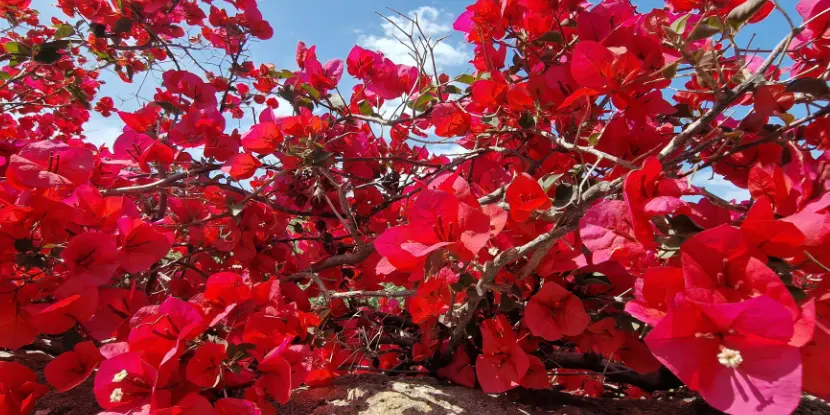
Bougainvillea genus of thorny ornamental vines, bushes, and trees belonging to the four o’ clock family, Nyctaginaceae.
Disease Control
Common plant diseases affecting bougainvillea include:
- Bacterial and Fungal Leaf Spot: Prune affected areas and remove infected leaves immediately to prevent spread
- Mildew: Apply a fungicide when transplanting the plants to reduce chances of infection and prevent root rot
Natural control methods for these diseases involve:
- Using a mixture of neem oil and water (2 tablespoons of neem oil in 1 gallon of water) to spray the leaves thoroughly
- Regularly inspecting plants for early signs of disease and maintaining a clean growing environment to discourage pathogens
FAQs: Bougainvillea Plant Care
Q: How often should I water my Bougainvillea in Southern California?
Bougainvillea plants thrive with deep watering once every 3-4 weeks. They prefer dry soil between watering. During the hotter months, you may need to water more frequently, but ensure the soil has dried out before watering again. Over-watering can lead to root rot.
Q: Can Bougainvillea tolerate full sun in Southern California?
Bougainvillea are sun-loving plants and can handle the strong Southern California sun. They require at least 5-6 hours of direct sunlight daily to produce the best blooms. More sunlight often leads to a more spectacular display of flowers.
Q: What is the proper way to fertilize Bougainvillea in this region?
Fertilizing should be done during their blooming period with a high-phosphorus, water-soluble fertilizer to encourage flowering. Apply it every four to six weeks from early spring through mid-fall, following the manufacturer’s instructions.
Q: What type of soil is best for planting Bougainvillea?
Bougainvillea prefers well-draining soil, as it does not like ‘wet feet.’ In Southern California, use a mixture of peat, pine bark, and coarse sand for optimal growth. This combination ensures proper drainage and aeration.
Q: Is it necessary to prune Bougainvillea, and if so, when?
Yes, pruning is essential to maintain shape, encourage new growth, and maximize flowering. The best time for pruning is in early spring, after the last frost date but before the new growth starts. Always use clean, sharp tools to make smooth cuts.
Q: When is the best time to plant Bougainvillea in Southern California?
The ideal time to plant Bougainvillea is spring, following the last frost when temperatures rise. This season provides the plant with ample time to establish its roots before the onset of the hot summer months.
Q: Can Bougainvillea be grown in pots, and how should they be cared for?
Bougainvillea grows well in pots, which allows you to move the plant to optimal sunlight locations. Pots should have good drainage. Choose a pot that can accommodate the plant’s growth over time.
Q: How do I protect my Bougainvillea during a rare Southern California freeze?
On the occasional cold night, cover your Bougainvillea with frost cloth or burlap. Also, try to place potted plants in a sheltered area, like against a warm south-facing wall, or move them indoors if possible. Remove the coverings during the day to allow sunlight and prevent overheating.

